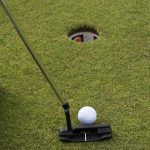Accuracy Matters-that’s the slogan on the cover of Golfbuddy’s LR5 rangefinder and the better you get at golf, the more it becomes important. When I was happy to break 100 it was probably enough to know which direction the green was! I exaggerate (slightly-you should have seen me spraying it all over the course!) but once you get at least semi-serious about golf, knowing how far it is to hazards, lay-ups greens and bunkers does make a tangible difference to your score.
The short Version
I was tempted to say something like ‘A great budget rangefinder’ but realised that this is a lazy way to describe the LR5-it implies cheap and adequate, but not great. The reality is, this is very good piece of kit. Robust, easy to use and accurate at an attractive price. For most golfers, getting a more expensive option is going to be a matter of choice (which is fine) but not necessity because this type of rangfinder is perfect for almost all of us.
Find it here on Amazon
As I said in my 2017 Best Rangefinder review, there are some really good options for all budgets and really no excuse to guess at the distance unless you choose. I really didn’t need anything else to work my way around the course, but I have been intrigued by the LR5 for a while and decided to take it for a test run. Actually, I decided to buy it pretty much sight unseen!
This might seem like an unusual move, but there were two good reasons:
- Firstly, I have played with a significant number of people this year who were using this device and were more than happy with it.
- Secondly, after using my playing partners’ Golf Buddy, I have a nagging feeling that it should have made the best of 2017 list.
So how does it stack up to the big boys in the laser optics field? Is is a real competitor to Nikon, Bushnell or Leupold? And perhaps most importantly of all, just how well does it live up to the ‘Accuracy Matters’ slogan? As a guy who likes a minimalist approach on the curse, at least sometimes, could this be a perfect simple solution?

Unboxing the GolfBuddy LR5
First things first, you might have noticed that the LR5 has actually been “updated” with the LR7. So why not simply test the new model? A couple of reasons. A rangefinder is expensive (although not as much as you might think) and not everyone is looking for the absolute newest. The LR5 is still part of the Golfbuddy Range, still available online and represents an excellent deal in my opinion.
Secondly, as someone who obsesses over all things golf (surprising for anyone running a golf blog, right?) I spend as much time as possible on the course or range, talking to other golfers and looking at what they are using. I have seen a lot of LR5 units but haven’t come across anyone with an LR7 yet. This tells me that maybe the 5 series is worth looking at.
There are some relatively small differences between the two models (and we’ll look at them later on) but it is far from night and day. Unless you have money buring a hole in your pocket, the upgrade certainly isn’t an absolute necessity.
Two Handy Ways to Close the Protective Case
So what is in the box? All fairly standard really. Inside the case is a a zip up pocket that can clip onto your golf bag. While this is far from revolutionary, I did like a couple of details. One, it is actually sturdy enough to offer some protection. When I play a few holes, particulalarly when trying out new clubs, I tend to use a light weight Sunday bag (this one if anyone is interested) and so anything in the pockets can take a bit of a hammering. For this reason, I am at least a bit wary of putting several hundred dollars worth of optics in there. THe golfbuddy case actually feels pretty sturdy and it has been in the front zip pocket of my carry bag regularly without any problem.
The other plus point for me is to do with the dual-closing system. As well as the standard zip, there is an elastic cord that loops round a catch on the other side of the pouch, making for very easy (and fast) opening and closing.
Now before you simply forget about this and write me off as someone who is too lazy to open and close a zip, hear me out. Yes, I am very lazy, but until if you haven’t used a zip pouch a couple of times a hole for 18, you don’t know just how annoying it can become. The zip runs smoothly, but it goes almost all the way round the outside and it is just a few seconds that becomes old pretty fast. Hooking and unhooking the elastic just seems a whole lot easier for some reason.
GolfBuddy Battery Life
The other thing worthy of note was the battery. why is it that no laser rangefinder every has a standard AA or AAA battery? Admittedly, I know nothing about batteries so there may be a good technical reason for this, but it just seems like an unnecessary complication.
The trial battery incuded in the box died pretty much immediately, however this is par for the course nowadays with most electronic goods and I at least had had the foresight to get another (although obviously it took me three shops to find the right size!)
Fitting a new battery was a piece of cake though. A sturdy rubber screw on the front means that there is no messing around with tools and the job took less than ten seconds. As for battery life, after a couple of months it is too early to say. I did ask those whom I met on the course and who were using the Golfbuddy and nobody had anything negative to say about batteries (or, indeed, anything else to do with this rangefinder.)
One of my regular playing partners said he couldn’t remember when he chnaged the battery but was sure it had been well over a year. Given that this guy palys several times a week, batery usuage shouldn’t be either a probelm or a hidden cost. The new battery I bought cost around 5 euros, so probably under $6 or £5.
Using the Golfbuddy LR5
So on to actually using the laser. The first thing I did was to start zapping stuff out of the window (after all, the distance from my desk to the far side of the room isn’t much of a challenge!) I actually started playing with the device before reading through (thankfully lightweight and easy to understand) instruction manual. I do this because I am lazy (see above) and lso because I believe that something like a rangefinder should be intuitively eay to use. If you need an advanced degree in electronics to make the damn thing work, what’s the point?
Now here is where the Golfbuddy really shines for me: ease of use. I have played with some extremely top-end laser rangefinders and, to be honest, I sometimes feel even more ignorant than usual. This can be even more true with GPS devices, where you have to scroll through a host of menus before being able to find the information you need.
Using this was simple. Point, push the button, read the distance. Really, when push comes to shove, this should be the bottom line. I am not the best at fixing tiny objects (like a flag) with a steady hand from 200 yards, but I really didn’t have any bother at all. The flags on my home course don’t have reflective prisms for easy capture and it was still very easy to fix them.
As always, I did occasionally get something like a tree behind the green, but this is where the different modes on the LR5 did exactly what they were supposed to do.
Three Different Modes
As with many recent rangefinders, there are several different modes available. I am always a bit wary of anything that sounds like ‘gadgetry’. You know, the thing that looks good on paper, but actually does nothing or actually makes things far more complicated than they need to be. This really isn’t the case here and all three modes work as described and do a job.
Distance Mode
Nothing surprising here-point the laser at the target, push the button, get the distance. Easy to use and sufficient for anything that can easily be fixed, either because it isn’t too far away, or there isn’t anything in the background which will cause you to get the wrong reading (and airmail the green as you pure a seven iron when it should have been a nine!)
Scan Mode
This comes into its own when you have several targets. This might mean that you want to get an overview of the hole as you are standing on the tee box, for example. You can see distances to dog-legs, fairway bunkers and other features in one continuous ten-second scan. This is also useful for seeing the difference between say the flag and whatever is in front of behind the green. It lets you quickly calculate just how much space you have if you hit that wedge a little fat over the bunker.
Pin Mode
This does essentailly the same thing as scan mode, but with one key difference. As you scan for ten seconds, the distance shown is the one to the nearest object. This is actually really smart and in many ways rules out the need for something like a vibration when you lock on the flag stick which other (especially high-price) models have. If you aren’t sure whether you have actualy got the flag stick or the trees behind, simply scan over the flag and the trees and shortest distance will appear (to the flag)
Switching between the modes (and changing from yard to meters) is simple. There are just two buttons on top. The furthest one from your eye is the mode button. The other button turns the unit on and off as well as activating the laser once you have fixed on the target. Really, it couldn’t be much simpler. Of course, if you are a real gadget geek, there are rangefinders with more bells and whistles. I do like technology, but on the course isn’t my favourite place to get frustrated by anything complicated-I really on my errant ball-striking and frankly embarrassing putting for all the frustration I might need on-course!
Last be not least in terms of functionality is the automatic switch off. I don’t bother turning it off at all once I’ve got my distance-simply back in the holder, flip the elastic closed and it turns itself off after a few seconds of inactivity.
Personally, I use one of the millions of pockets on my cart bag keeping it easily accessible because I tend to use a pushcart nowadays if I am not using the Sunday bag. However, you could easily stow it on the dash of the cart given that it is so compact-Less than 200g and it almost disappears in my giant paws! I didn’t have any problem with things being too fiddly though, despite the size. Personally, I don’t mind swinging with my pockets full and it does fit in both the front and back pockets of my golfing trousers. I know that many find this offputting though, much like wearing a bulky GPS watch to play (although again, that never bothers me.) There is a sturdy carabiner if you want to hook it to the outside of your bag as many do.
The actual optics are middle of the range in terms of specs. 6 times magnification and a max range of 600 yards makes for a very solid performer. You can find slightly better. for example, the latest leupold has 7 times magnification and there are a couple of rangefinders that give over 800 yards range. However, this begs the question ‘Why?’ Unless you really struggle with your eyes (in which case a rangefinder could be tricky) 6 times magnification should be plenty to get as much detail as needed and to fix on any flag.
As for the maximum range, honestly, even 600 yards is more than I would ever use. There aren’t even many par fours of 400+ yards where you can see the flag from the tee and even if you could, why bother? The longest distance I might need would be to something like the far side of a dog leg to see where the fairway runs out off the tee. Unless you are planning on competing in long drive any time soon, 300-35 yard should cover most mortels.
Of course, I did try zapping things in the far distance just to see and had no reall issues getting 400+ yards. Rgardless of what any manufacturer tells you, fixing on a flag at that sort of distance does take a steady hand and often a try or two, but it was certainly doable so a tree at 350 yards or a pin at 250 isn’t a bit problem.
FAQ
How easy is it to use?
Short answer:very! Of course, there is always a trade off between ease-of-use and features. The more you have, the more complicated it gets. Many people look for all the bells and whistles, but when you use a rangefinder regularly, you don’t want superfluous stuff. The LR5 has what it needs and that’s it. Anyone should be using it without an issue the first time on the course.
LR4 vs LR5 vs LR7
This is always a tough one (and it applies to virtually everything)-at what point is the latest model ‘worth it?’ As with this year’s driver compared to last years, it is often a matter of degrees. It can even be a simple matter of changing the colour scheme!
In my opinion, the LR5 does a slightly better job than the LR4, but the difference is small. If I had the version 4, I wouldn’t be rushing out to buy the 5. If I had neither, I would almost certainly buy the 5 over the fuor and in fact that’s just what I did!
As for the LR7, you might need to tke what I say with a pinch of salt because I haven’t tried it out on the course. I would guess that it would be very similar. The only major upgrade might be the vibration feature. This is handy for fixing flags, but I have found this so easy to do with the LR5 that I have never felt like I needed a vibration feature. Bear in mind that I really amm fairly bad at keeping any rangefinder steady and you should get an idea of just how easy it is.
The LR5 is available on Amazon








